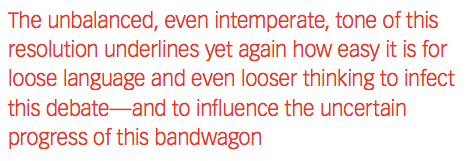A Discordant Bandwagon
Pharmaceutical Executive
The Council of Europe is the latest group to jump into the drug-pricing debate blazing its way through continent.
The Parliamentary Assembly of the Council of Europe is the latest to clamber aboard the well-filled bandwagon now rumbling and rattling across Europe in an increasingly noisy debate over drug prices. The what? The weary reader might well ask. Drug prices have been a bone of contention for decades in Europe, so what’s so special about this new intervention?
The novelty demonstrates something remarkable-that the issue of drug prices has now attained such political signifi- cance that everyone seeking a profile in Europe wants to say something about it. The Council of Europe is not the same as the European Union (EU)-it’s much older, going back to 1948, and has many more members-47, stretching from Iceland to Azerbaijan. It doesn’t have the same clout as the EU, either, because it can’t make binding law. And its Par- liamentary Assembly is often seen as a very low-grade equivalent of the EU’s European Parliament.
But intellectual powerhouse or not, the Council of Europe is clearly determined to get involved in the discussions of drug pricing. And its take on how to solve the problems of access to new medicines should make every pharmaceutical executive ring downstairs to ask what the hell the corporate government affairs department is doing with its budget.
This august body, drawn from the national parliaments of its member countries, has signed off on a text that notes “particular concern” over “the exorbitant price of cancer and hepatitis C treatments.” It comments adversely on the “upsurge” in drug prices, “allegedly justified by the cost of research and develop- ment, which, nonetheless, remains opaque and broadly disputed,” and it calls on national governments to “oblige pharmaceutical companies to ensure absolute transparency regarding the real costs of research and development.” The costs are “jeopardizing public health systems,” it says.
IP model scrutinized
At the same time, the resolution openly questions the intellectual property rights that drug firms obtain to protect their innovations, and “in order to ensure the viability of health systems and the accessibility of affordable and innovative medicines in the long term,” it calls on the World Health Organization “to put forward alternatives to the current patent-based pharmaceutical innovation model.” The underlying assumption is that drug firms are foisting an endless stream of worthless “me-too” products onto helpless health authorities through a mixture of concupiscence and abuse of power.
Among medicines launched in recent years, it says, “there have been very few that present a real therapeutic benefit, satisfying real health needs.” It draws a link with the “negative effects of the interaction between the pharmaceutical industry and health sector stakeholders” and warns that conflicts of interest resulting in “biased decisions” are still not adequately prevented because of “hit-and-miss” methods and ineffectual industry self-regulation. Governments should introduce tougher reimbursement criteria such as added therapeutic value or a need clause, and ensure that health-related decisions “are not profit-driven.”
Feeding the frenzy
The unbalanced, even intemperate, tone of this resolution underlines yet again how easy it is for loose language and even looser thinking to infect this debate-and to influence the uncertain progress of this bandwagon as it bumps its way awkwardly around the continent.
The bandwagon was given its first big push into motion by that classic example of disruptive innovation, the hepatitis C drug Sovaldi. First on board, of course, was the drug firm itself, with its effective treatment for a deeply serious and expensive condition that had hitherto defied all attempts at a simple and sure-fire cure-and vigorously waving its demands for adequate payment accordingly. Healthcare payers jumped up in alarm at the prospect of such a costly drug for a widespread condition; an expensive treatment for a rare disease is one type of problem-but for a common disease?
Patient groups were next to join the party; there are pressing needs, they claimed, and if there are medicines to meet those needs, they should be available. Industry, too, seeing an excellent opening for putting a spoke in the wheel, seized on Sovaldi as demonstrating the need for a deep rethink of drug pricing policy in Europe. This provoked member state governments to get involved. Led by Italy and strongly supported by France, they held talks on how they might force the hand of avaricious drug firms, and eventually settled for a serieso f rather more innocuous commitments to explore closer cooperation.
Over the course of 2015, the bandwagon has gathered pace. The EU is funding studies on possible new pricing systems, it has committed itself

to a further phase of joint assessment of health technology, and it has set up a new expert group on securing “timely access to medicines.” The European Parliament has emitted an almost ceaseless stream of resolutions and ques- tions and statements drawing attention to the plight of patients denied access to medicines they need.
In meetings up and down Europe and across the Atlantic, senior industry figures now sit down with senior drug regulators to talk of how they might bridge the gap between “we’ve got a good drug that’s going to cost you a lot” and “our citizens certainly need it but we just can’t afford it.” And some member states are having a go at pioneering, on a small scale, the sort of cooperation that is starting to be seen more widely as the way to go to find solutions to what still looks like irreconcilable opposites.
Access: The key hurdles
Another recent recruit to the debate is BEUC, the European consumers federation. It says consumers’ access to medicines in the EU is being hampered by three hurdles. One is that medicines that consumers need are not being developed. BEUC says recent medical innovation has neglected most disease areas. Another obstacle is that new life-saving medicines and older key medicines may be unaffordable. “Spanish households now pay 58% more for their medicines than in 2010, and 39% of Portuguese consumers could not afford a medicine they needed in 2014.” And on top of that, some drugs might be out of stock because of shortages. “Negative consequences on safety and quality of care inevitably result,” says BEUC.
The organization’s director general, Monique Goyens, isn’t looking for an easy compromise. “Everyone should be able to get the right drug at the right place and the right time,” she said as she launched a BEUC strategy document in late November. “It is urgent that price tags become more reasonable, ethical, and sustainable.”
Real solutions sought
So much for the analysis. What about the recommendations? Policymakers need to get drug firms to “direct research financ- ing to areas of public health need,” and “a clear definition of an ‘unmet medical need’ should be agreed.” And member states should explore new ways to share data on medicines prices and possible joint initiatives to drive costs down. Progress also requires that “profits should be balanced with affordability,” and “an EU-wide assessment of the added value of new and existing medicines (i.e., what benefits they have for patients compared to the alternatives) is needed to guarantee consumers get a good value for money.”
Here, too, there is some imprecision in the argument, leaving an impression that the critics remain vociferous, but continue to be stronger on rhetoric than on substance. What one is bound to ponder would be the price tags that Goyens says should be “more reasonable, ethical, and sustainable.” It is a glib observation, because the concept of a reasonable price is bound to vary between the buyer and the seller. To simply state this as a goal, without any indication of how it might be achieved, is not a huge service to the debate. Similarly, her call to balance profit with affordability has a looseness to it making it easy to say but of limited value without some real explanation of how.
The fuller the bandwagon becomes, the more erratic its journey through the difficult terrain of a drug pricing debate that really merits exploration-but merits exploration of a more considered nature.
Reflector is Pharmaceutical Executive’s correspondent in Brussels.

Addressing Disparities in Psoriasis Trials: Takeda's Strategies for Inclusivity in Clinical Research
April 14th 2025LaShell Robinson, Head of Global Feasibility and Trial Equity at Takeda, speaks about the company's strategies to engage patients in underrepresented populations in its phase III psoriasis trials.
Beyond the Prescription: Pharma's Role in Digital Health Conversations
April 1st 2025Join us for an insightful conversation with Jennifer Harakal, Head of Regulatory Affairs at Canopy Life Sciences, as we unpack the evolving intersection of social media and healthcare decisions. Discover how pharmaceutical companies can navigate regulatory challenges while meaningfully engaging with consumers in digital spaces. Jennifer shares expert strategies for responsible marketing, working with influencers, and creating educational content that bridges the gap between patients and healthcare providers. A must-listen for pharma marketers looking to build trust and compliance in today's social media landscape.
Pfizer, GSK Gain ACIP Recommendations for RSV and Meningococcal Vaccines
April 18th 2025The Centers for Disease Control and Prevention’s Advisory Committee on Immunization Practices voted to expand access to Pfizer’s respiratory syncytial virus vaccine Abrysvo for high-risk adults in their 50s and voted in favor of GSK’s meningococcal vaccine, Penmenvy, for streamlined adolescent protection.